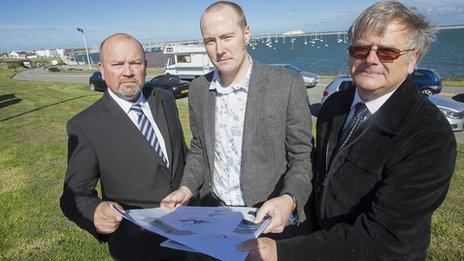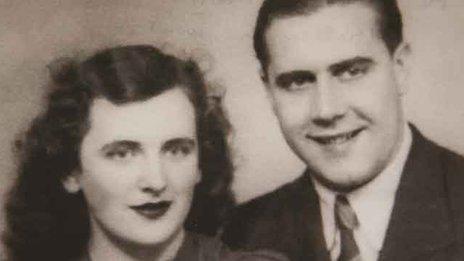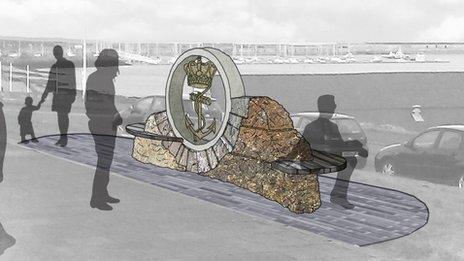Holyhead's memorial to World War II Dutch mariners
- Published

Graham Van Weert (right) and Councillor J Arwel Roberts and architect Matt Osmont consider the plans for the memorial
Holyhead harbour is to become the site of a memorial to one of World War II's greatest stories of escape, survival, love and tragedy.
As Germany invaded the Netherlands in 1940, thousands of sailors from the Dutch Navy fled in whatever ships they could put to sea.
Hundreds steamed to Holyhead, a key stage on the Atlantic Convoys.
Now a memorial bearing the bronze crest of the Dutch Navy is to be erected in their honour.
Graham Van Weert's father, Mathieu, was an 18-year-old when he fled Holland and made his way to Holyhead via Portsmouth and Falmouth.
"They just took whatever ships they could to stop the Germans getting them," said the retired fireman, 60, who is writing a book about the Dutch Navy in Holyhead.
Billeted
"Twenty-three of them took a cruiser, the Jacob Van Heemskerk, which normally had a crew of 400 and sailed it across the North Sea."
"Many of them ended up here in Holyhead, like my father, and many of them were on minesweeping duties because Holyhead was very important on the Western Approaches."
As happened with troops from all over the world billeted in Britain, many of the Dutch sailors found love on Anglesey.
Mr Van Weert's research has unearthed 116 examples of marriages between Dutch servicemen and local girls - including that of his own parents.

Graham Van Weert's parents Megan and Mathieu met after he fled to Holyhead
"A lot of them settled down here like my father. He married my mother whose name was Megan Parry and my grandparents were quite sceptical about people who came from away - they thought people from Beaumaris were a bit strange."
"There used to be dances here and that's how they met. She saw her future husband through a shop window and that was just one of so many romances."
But for these fledgling families, VE Day represented the start rather than the end of their heartache.
As the Dutch sailors were ordered home, their wives and girlfriends faced a stark choice - to wave goodbye to their sweethearts, or to begin a new life in a foreign country.
"Many of the families were torn apart at the end of the war. They were treated as displaced nationals because they had married Dutch men and had to go back to Holland," said Mr Van Weert.
Railway platform

"Lots of them had never been as far as Llangefni.
"Luckily for my mum she didn't have to go back to Holland then, but she had to go to Liverpool to get a Dutch passport.
"I've still got lots of relatives over in Holland because my dad came from Maastricht and we used to go over there every year - there would be about 40 of them on the railway platform to meet us, and they have been over here too."
The funding for the memorial has come from the Heritage Lottery Fund, through the Community Heritage Initiative for Maritime Engagement.
Isle of Anglesey Council, Holyhead Town Council and community groups have also made contributions.
The memorial will also feature benches made from locally-salvaged oak and teak.
- Published29 May 2010